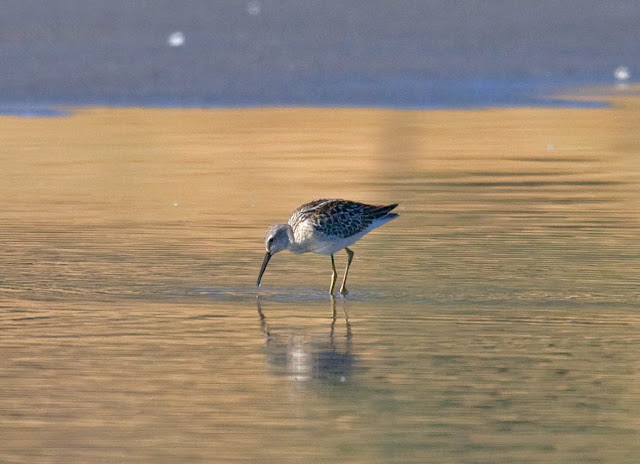So it was that on October 23rd I found a Solitary-type vireo in Escondido. A few years back the Solitary Vireo was spit into 3 species: Cassin's in the West, Blue-headed in the East, and Plumbeous in the Inter-Mountain West. I have seen all three, but only Cassin's regularly, and more often heard than seen (or heard first then observed as barely more than a silhouette moving through the forest canopy).
When the bird first appeared I was convinced I was viewing a Plumbeous Vireo. There was great contrast between the dark gray head and white eye ring and supra-loral ("spectacles"). The wingbars were wide and white. I could detect no green or yellow tones in the field. Many Cassin's Vireos are quite greenish overall, but this bird was very gray and white.
However, when I got home and transferred the photos to my computer, I could definitely see a pale yellow wash to the sides. The back that looked so gray in the field now had a slightly olive cast to it. Did that mean it was actually Cassin's?
Eventually I put it down in eBird as "Cassin's/Plumbeous Vireo"--a safe, but ultimately unsatisfying, "non-identification."
Time for some research.
 |
| Mystery Vireo. Kit Carson Park, Escondido, California. October 23, 2016. Greg Gillson. |
 |
| Mystery Vireo. Kit Carson Park, Escondido, California. October 23, 2016. Greg Gillson. |
 |
| Mystery Vireo. Kit Carson Park, Escondido, California. October 23, 2016. Greg Gillson. |
My research found that this vireo undergoes a complete molt in fall. Indeed, the bird shows fresh, crisp, new plumage. This is the brightest and most colorful plumage of the year. From here on out over the next 10-11 months the plumage will wear and fade. So my initial feeling that the bird was Plumbeous was perhaps more due to the unfamiliar-to-me fresh fall plumage--I usually only see Cassin's in duller spring and summer plumage. ["Plumbeous Vireo: the range of misconception," BirdFellow blog, Dave Irons, 2014.]
In very worn plumage the Cassin's Vireo can approach Plumbeous in colorless gray with little hint of yellow on sides and secondary edging. After the fall molt Cassin's can appear nearly as bright and colorful as Blue-headed Vireo. ["Spectacled Vireos," PRBO Observer, Rich Stallcup, 2007.]
[Unfortunately I do not have access to Heindel, M.T. 1996. Field identification of the Solitary Vireo complex. Birding 28:458-471.]
Since this bird is in fresh plumage and is still rather gray with a hint of yellow on the sides, a slight olive cast to the back in one of the photos, and at most only two outer secondary feathers a bit yellowish, it would seem to best match Plumbeous Vireo... maybe.
Plumbeous is supposed to have a larger bill and longer tail than Cassin's. I don't have much basis for comparison, but these aspects do not appear so different from the Cassin's Vireo below, photographed May 29, 2010 in Harney County, Oregon. The worn plumage is especially obvious in the near lack of wing bars.
 |
| Cassin's Vireo: May 29, 2010. Harney County, Oregon. Greg Gillson. |
 |
| Cassin's Vireo: May 29, 2010. Harney County, Oregon. Greg Gillson. |
Yes! I hate not being able to put a name on a bird.





















